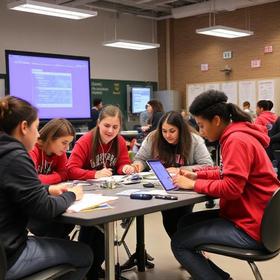Focus Beyond serves 198 students in grades 9-12.
The percentage of students achieving proficiency in math is <50% (which is lower than the Minnesota state average of 65%).
The student-teacher ratio of 9:1 is lower than the Minnesota state level of 13:1.
Minority enrollment is 76% of the student body (majority Black and Hispanic), which is higher than the Minnesota state average of 39% (majority Black and Hispanic).
Quick Facts (2025-26)
- School Type: Special education school
- Grades: 9-12
- Enrollment: 198 students
- Student-Teacher Ratio: 9:1
- Minority Enrollment: 76%
- Graduation Rate: ≥50% (Top 1% in MN)
- Math Proficiency: <50%
- Source: National Center for Education Statistics (NCES), MN Dept. of Education
Top Rankings
Focus Beyond ranks among the top 20% of public schools in Minnesota for:
Category
Attribute
Diversity
Percent Eligible For Free Lunch
Student Attention
School Overview
Focus Beyond's student population of 198 students has declined by 19% over five school years.
The teacher population of 22 teachers has stayed relatively flat over five school years.
School Type
Grades Offered
Grades 9-12
(No virtual instruction)
(No virtual instruction)
Total Students
198 students
Gender %
Total Classroom Teachers
22 teachers
Year Founded
2025
School Calendar
Last Day of School
Wed. Jun 10, 2026
School Rankings
The diversity score of Focus Beyond is 0.77, which is more than the diversity score at state average of 0.59. The school's diversity has stayed relatively flat over five school years.
Math Test Scores (% Proficient)
(09-10)<50%
65%
Student-Teacher Ratio
9:1
13:1
American Indian
2%
2%
Asian
18%
7%
Hispanic
18%
12%
Black
33%
12%
White
24%
61%
Hawaiian
n/a
n/a
Two or more races
5%
6%
All Ethnic Groups
Graduation Rate
(20-21)≥50%
84%
Eligible for Free Lunch
79%
36%
Eligible for Reduced Lunch
3%
7%
School Statewide Testing
School District Name
Source: National Center for Education Statistics (NCES), MN Dept. of Education
Profile last updated: 02/09/2025
Frequently Asked Questions
What schools are Focus Beyond often compared to?
Focus Beyondis often viewed alongside schools like St. Paul School Of Northern Lights, Great River School by visitors of our site.
What is the graduation rate of Focus Beyond?
The graduation rate of Focus Beyond is 50%, which is lower than the Minnesota state average of 84%.
How many students attend Focus Beyond?
198 students attend Focus Beyond.
What is the racial composition of the student body?
33% of Focus Beyond students are Black, 24% of students are White, 18% of students are Asian, 18% of students are Hispanic, 5% of students are Two or more races, and 2% of students are American Indian.
What is the student-teacher ratio of Focus Beyond?
Focus Beyond has a student ration of 9:1, which is lower than the Minnesota state average of 13:1.
What grades does Focus Beyond offer ?
Focus Beyond offers enrollment in grades 9-12 (No virtual instruction).
What school district is Focus Beyond part of?
Focus Beyond is part of Saint Paul Public Schools.
In what neighborhood is Focus Beyond located?
Focus Beyond is located in the West Seventh Fort Road neighborhood of Saint Paul, MN. There are 21 other public schools located in West Seventh Fort Road.
School Reviews
Review Focus Beyond. Reviews should be a few sentences in length. Please include any comments on:
- Quality of academic programs, teachers, and facilities
- Availability of music, art, sports and other extracurricular activities
Recent Articles

The Impact of Social Media on Students – 2025 Updated Insights
Explore how social media affects students’ academic performance, behaviour and wellbeing in 2025 with expert insights and policy updates.

The Push for Career and Technical Education (CTE) in 2025
Discover how CTE is transforming U.S. high schools and colleges in 2025: new policies, updated data and best practices for students and educators.

School Lunch Programs: A 2025 Update on Past and Present
Explore the evolution of U.S. school lunch programs, updated for 2025—policy, participation, nutrition, and how schools serve students today.





